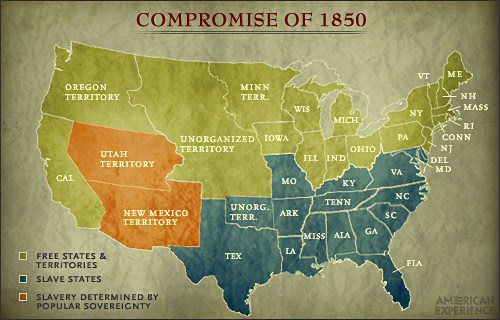Chances are that you’ve either experienced first hand or have heard a story about someone who didn’t know New Mexico is a U.S state. Perhaps you had a family member who was planning to visit you in the Land of Enchantment, but were told by their ticket agent that they needed a “valid passport” to do so. This actually happens so frequently, that there is a monthly compilation of stories called, “One Of Our 50 Is Missing,” where they detail countless stories on their site. Perhaps it’s innocent and the person didn’t hear you say “New” in front of “Mexico,” but often times, people genuinely think that New Mexico is actually in a foreign country. While it can be humorous, it’s not the first time that New Mexico has been viewed as a “foreigner.”
New Mexico Statehood Timeline


We Faced Major Hurdles
In fact, New Mexico faced a major hurdle to become a part of the United States because we were viewed as outsiders. After signing the Treaty of Guadalupe Hidalgo in 1850 (which ended the Mexican-American War and later pronounced New Mexico as a United States territory), the U.S had never acquired a territory with such a large foreign population so quickly. At one point, after the annexation of New Mexico and post Civil war, General William T. Sherman was quoted stating, “The United States ought to declare war on Mexico and make it take back New Mexico.” New Mexico was primarily Catholic, spoke Spanish, was viewed as poor, in addition to having a reputation for lawlessness. All of these elements in combination created a bad reputation for the state as foreigners.

It’s clear those roots run deep because New Mexico continues to face similar issues today, although on a much smaller scale. New Mexico is one of four Minority Majority states, where we have the highest concentration of Latino and Hispanic population in the U.S. at 48 percent. Each time the idea of statehood was introduced, many Americans and lawmakers were skeptical that New Mexicans were loyal and worthy of becoming official American citizens.
A Long & Difficult Road to Statehood
New Mexico’s 66-year, long and difficult road to become a part of the Union faced a variety of roadblocks in addition to being seen as outsiders. New Mexicans themselves were not all convinced that statehood was the best path forward plus partisan politics was also partly to blame. As the 20th century dawned, New Mexico was finally making strides toward steady economic growth, had began instating educational institutions, and had bountiful natural resources. New Mexico, however, still remained “a land a part.” To some degree, this narrative sounds familiar over a century later.
It was difficult to beat the external perception that revolved around New Mexico. In 1898, President William McKinley sent a telegram to Governor Miguel A. Otero, Jr. during the Spanish-American War asking him to assist in recruiting young men who were good shots and good riders. This is when the famous Rough Riders (the first U.S Volunteer Calvary under Theodore Roosevelt) came and paved the way for statehood through a show of bravery and loyalty. This in turn helped prove that New Mexicans were willing to fight on behalf of the United States and that their loyalties were with the Union.

A picture of the famous Rough Riders – Picture from PBS.org
Finally Making Moves
Following the Spanish-American War, Congress took up a bill to bring Oklahoma, New Mexico and Arizona into the Union in 1902. This time, rather than speculating about the foreign territories, members of a Senate Committee actually toured New Mexico to see and hear from its citizens. Unfortunately, the bill died in the Senate the following year, but just two short years later the statehood movement popped up once again. This time it was to bring New Mexico and Arizona into the Union as one state called, Montezuma. This proposal died when New Mexico’s territorial delegate, Bernard Rodey, made the case that the two territories contained distinct populations and were separated by a mountain range.
By 1910, the U.S. Census recorded New Mexico’s Territory population at 327,301 people, several railroads were in full operation and President Taft finally decided to pay New Mexico a visit. A state constitution was then written in 1910 and Congress took up statehood for New Mexico and Arizona again. A state constitution was later drafted and ratified in 1911, which helped New Mexico go one step further in its quest for statehood. After several months of negotiation, President Taft signed the bill, which promised statehood to both states. Finally, New Mexico was admitted into the Union as a state on January 6, 1912.

Admission to Statehood
This is a political cartoon by Clifford Berryman that appeared in the Washington Post on May 24th 1911.
Congress passed an act on June 20, 1910, to authorize the people of the New Mexico and Arizona Territories to form constitutions and state governments. Upon approval by Congress, these states would finally be admitted into the Union.
Did you know that the same New Mexico state constitution is in place today?
Photo from the Albuquerque Historical Society
Our Past Shaped Who We Are Today
To move forward, we must know and understand how our past has shaped who we are today. New Mexico’s road to statehood may give us clues as to why we have not kept up with the progress made by our peer states. To some degree, it seems we’ve been living up to the reputation we had been given over a century ago and has created deep psychological impacts on how we view ourselves. On the contrary, we know that diversity makes companies, teams and yes, even states, stronger. By the year 2060, the entire U.S will become a minority majority population – we’re simply ahead of our time. We can find strength in our diversity where everyone can come together in the united goal of pursuing the common good. Our journey to statehood was only a few generations back and we have the opportunity to learn from the past and grow from it. As our state motto says, “It grows as it goes,” we must refuse to stagnate, coming in last for everything. Our previous determination to become a state must be applied to making us a better place to learn, grown and thrive.
By nature, New Mexicans are durable, resilient, innovative and driven. Now it’s a matter of harnessing our determination and strengths to face our challenges head on. We have a diverse set of knowledge to cope with the problems of today. In order to change and become the state we all want to be, New Mexicans need to hold those who represent us accountable for taking on this challenge and make a difference. Through unity and collaboration, we can find the way forward and make impactful lasting changes in our state. Be a part of this change and join us today.



Follow Viante New Mexico for Updates